
Building with fungi
Did you know?
Expand your knowledge of fungi.
- A cubic inch of soil can contain so many mycelium filaments that, lined up end-to-end, they would reach almost 13 kilometres.
- These vast and complex networks can live for centuries, stretch over kilometres, and are even rumoured to help trees to communicate with each other.
- Engineers are working on mycelium materials that could regrow and repair themselves, which could one day lead to self-healing leather or even building structures.
Over the past two decades, scientists have experimented with growing mycelia – the networks of hair-like threads that sustain all fungi – to create new materials. And our mycelial appetite is mushrooming, with startups the world over securing millions in funding for their low-carbon, biodegradable (and sometimes edible) products. Now, scientists and engineers are turning to mycelia to help shape the buildings around us.
While mycelium is no replacement for concrete or steel, it does have potential for internal and non-load-bearing materials, from stud walls to doors and insulation. Since many construction materials are derived from petroleum, mycelium could be a good alternative.
Some companies and researchers are taking the concept even further, with early prototypes of temporary buildings made from mycelium bricks. Others propose living mycelial structures that can grow and shift with time. But what many mycelia-material proponents have in common is a belief in the need for a mentality shift in the way we construct and experience the buildings around us.
Flexible fungi
Unlike photosynthesising plants, fungi get energy from digesting organic matter such as cellulose and lignin. They can convert this into mycelium and fruiting bodies, such as mushrooms. Depending on the type of fungi, the medium they grow in, the CO2 content, temperature, and air humidity, mycelium can form materials with completely different qualities: rigid, foam-like, flexible, dense, loose, strong, or easily torn.
For example, mycelium can be grown as a ‘skin’ or layer on the surface of a liquid containing starch, sugars, yeasts, and other nutrients. Fermenting solid substrates is another approach to grow mycelium materials. Vegan leather grown this way by US-based Bolt Threads has already been used in Stella McCartney bags and Lululemon yoga mats. Mycelium vegan meat, which can resemble steak or bacon, involves a similar approach.
Mycelium can also grow in a dry layer of agricultural by-products, such as shredded corn husks, sawdust or straw. As the fungi part-digest the plant matter, they bind the remaining waste fibres in a rigid but lightweight composite structure. This can result in a material akin to polystyrene that can be used as packaging. In the UK, The Magical Mushroom Company has produced and sold over half a million pieces of packaging made this way, using an approach developed by US-based Ecovative. After use, mycelium packaging can be torn into smaller pieces and composted with garden waste, turning to soil in about 45 days.
Depending on the type of fungi, the medium they grow in, the CO₂ content, temperature, and air humidity, mycelium can form materials with completely different qualities: rigid, foam-like, flexible, dense, loose, strong, or easily torn.
Building with mycelium
While mycelium-based construction materials are still a nascent area, enough progress has been made for many a headline speculating about compostable future homes made of living fungus. But these are not wholly unfounded ideas.
The materials and foresight teams at Arup have been researching biomaterials such as mycelium in the built environment for over a decade. Back in 2014, they provided structural engineering for an eye-catching temporary structure made from mycelium composite bricks. This art exhibit, the Hy-Fi Tower, was installed in a courtyard at New York’s Museum of Modern Art (MoMA).
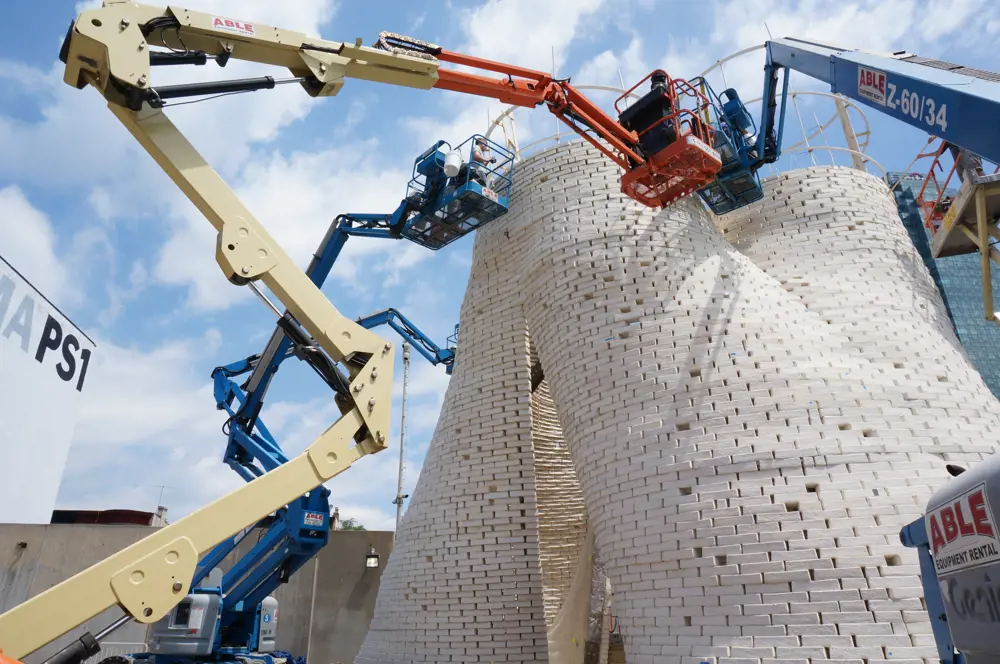
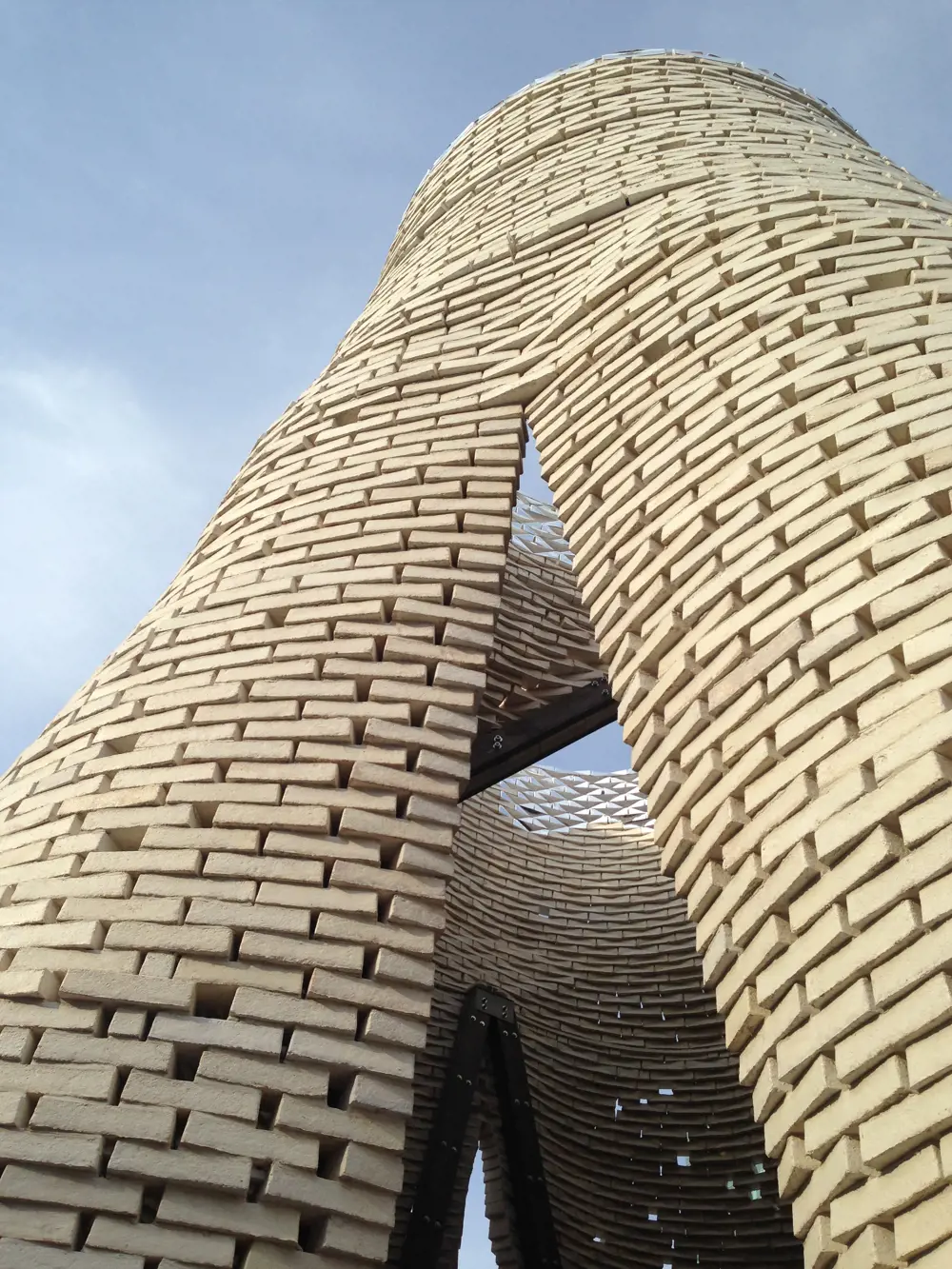
Arup’s engineers worked closely with New York-based architecture practice The Living to come up with a design. After testing the composite material’s strength, they calculated that the bricks (made using Ecovative’s approach) could be used in a structure up to 12 metres high. Aiming for a structure capable of withstanding 65 mph winds, their design featured a wide base and round towers.
This striking project numbers in the few that have used mycelium for external, load-bearing bricks. “There are still significant barriers for mycelium, including technical understanding, particularly in terms of longevity in exposed environments and structural applications,” says Florence Wu, a biomaterials specialist on the Arup team who has been involved in several recent mycelium-based projects, including an award-winning initiative to restore wetlands with floating mycelium islands.
Wu also worked on acoustic insulation tiles, conceived by Italian company Mogu. Mogu’s foam-like, sound-absorbing tiles are designed to reduce noise and echo in internal spaces such as offices. The company worked with Arup to determine the product’s technical specifications.
“In nature, fungi are formidable decomposers and recyclers, responsible for transforming dead organic matter,” explains Mogu’s co-founder, designer and engineer Maurizio Montalti.
“In our case, they hold the potential to process low-value materials, such as agro-industrial waste, and turn those into high-value materials and products.”
In nature, fungi are formidable decomposers and recyclers, responsible for transforming dead organic matter. In our case, they hold the potential to process low-value materials, such as agro-industrial waste, and turn those into high-value materials and products.
Maurizio Montalti, designer, engineer and co-founder of Mogu

How to grow a mycelium tile
Maurizio Montalti explains the production process of Mogu’s acoustic WAVE panels. “The challenge was not just to create a tile but also a protocol that would yield the same outcome every time. It’s a lot more complex than a chemical reaction because there are so many variables when dealing with biological processes,” he says.
Selecting the fungal strain
There are a mindboggling number of different fungi species (estimates range from 2.2 million to 5 million), while individual species can have many hundreds of strains. The Mogu team looked at 250 strains before settling on one that would support the development of an optimal product.
The substrate
The substrate on which the mycelium grows is a blend of residues from the textile and agricultural industries. Cotton that’s too impure to be used for fabric is blended with hemp fibres, hydrated and sterilised to eliminate microorganisms that could interfere with the fungus’s growth.
Incubation
The substrate is then mixed with fungal spores and used to fill special bags equipped with a filter that allows for gas exchange. The bags are stored at the optimal temperature for growth – about 25˚C – and incubated for a few weeks. As the mycelium grows, it turns the bags into dense white blocks.
Growth
Once the growing medium is fully colonised, the cultures are robust enough to be processed in the factory. The blocks are shredded and the fibres poured into moulds the desired shape of the tiles. These are placed on shelves in an incubation room with controlled temperature, humidity and CO2 concentration of air, similar to a vertical farming system. Now, the mycelium grows back very quickly, solidifying in the shape of the mould.
Sterilising
The semifinished tiles are then dried in a desiccator at about 70˚C to stop the biological activity of the fungus, turning it into an inert material.
Finishing
The tiles are finally treated with nontoxic substances to tailor technical properties such as fire resistance, depending on the space they are intended for. They can also be coloured with water-based paints.
Growing the data on mycelium
Testing was an integral part of product development. Mogu worked closely with the Arup team for this, gathering data on sound absorption, fire safety, compressive strength, humidity resistance, and performance after installation.
“We often had to go back to the drawing board when the result wasn’t in the accepted range or couldn’t be reproduced,” says Montalti. “There were many iterations. We shared the data with Arup, to… eventually [establish] a process that would consistently deliver a high-performing product.”
“We assessed and analysed their data in relation to building standards,” adds Wu. “Having robust testing and data that shows performance and compliance is crucial to gain the trust of the public, to inform engineers and builders, and enable policymakers to legislate, paving the way for wider adoption.”
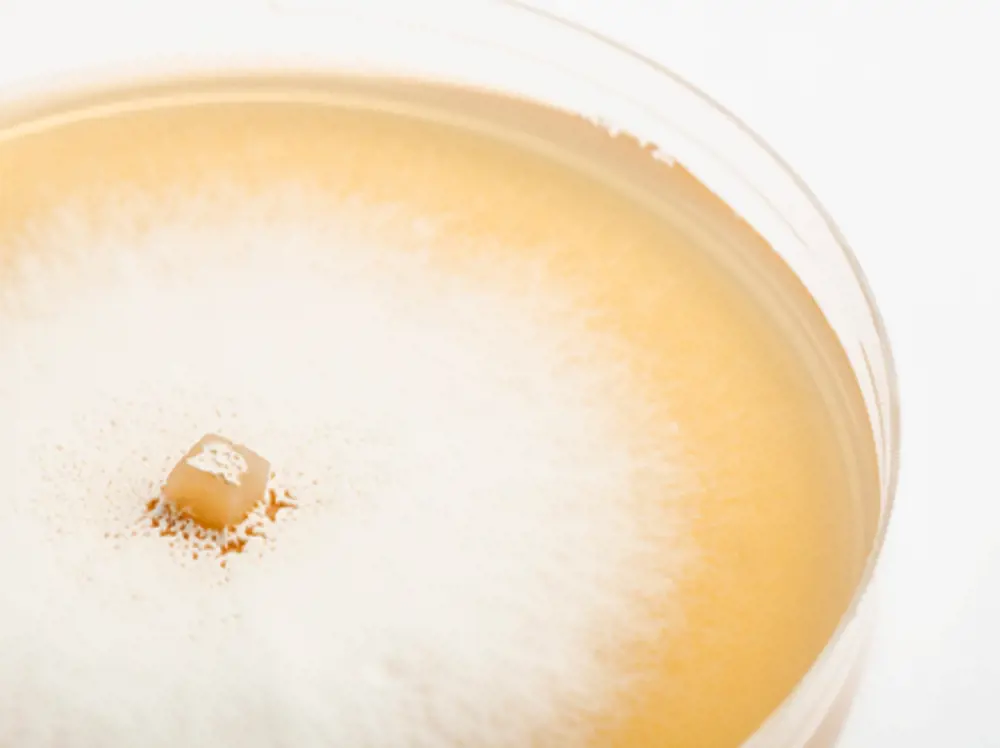
Despite the consumer appetite for materials with a lower environmental impact, as Wu points out, lack of data is a major barrier to biomaterials being more widely adopted. For instance, many mycelium products have limited data on durability. And without evidence that they fulfil specifications – either stipulated by building regulations, or performance required by a client – they are unlikely be used.
There is more manufacturers and researchers working with mycelium must do to better understand and tailor its properties. For instance, the amount of water it absorbs is important for indoor use, especially in humid climates. One mycelium expert has compared it to a sponge, noting it should be sealed with water repellent (which could compromise its sustainability credentials). Others report that mycelium composites, densely grown on the right substrate, have more suitable water absorption properties than clay bricks, mortar and glass fibre.
Either way, more R&D and case studies will clarify what is possible. The Living’s latest project will test mycelium as insulation, sandwiched between millimetre-thick sheets of a fibreglass shell, for the walls of prefab affordable housing units in California.
Cost is also an obstacle, with many mycelium products considered high end and niche. If projects such as The Living’s are successful, they could raise mycelium’s profile and in turn, demand for it, bringing down prices.
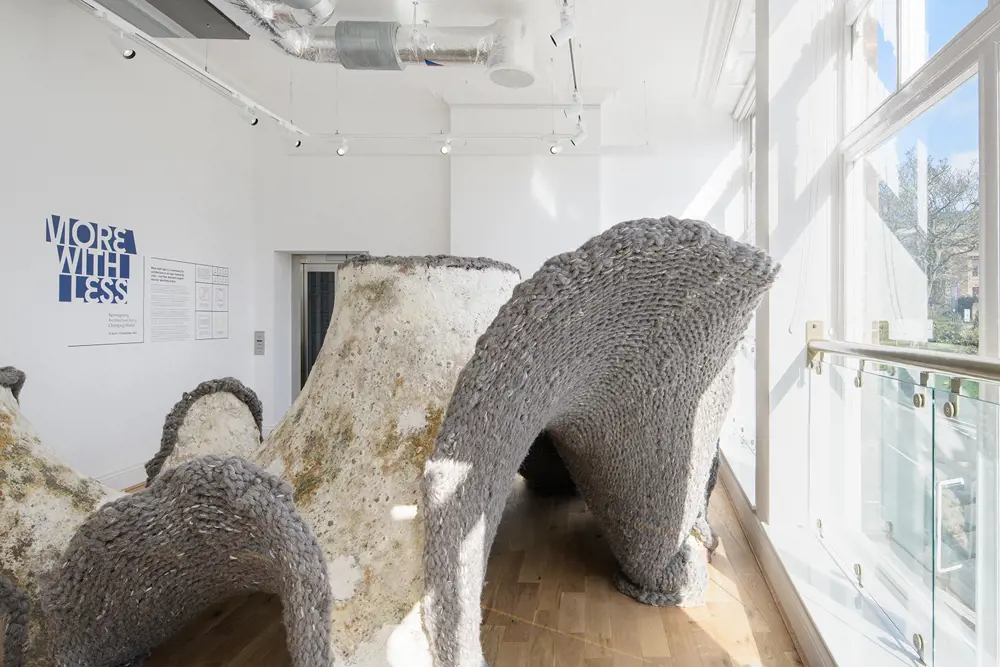
Living buildings
Dr Meng Zhang, an associate professor in microbial biotechnology at the University of Northumbria, believes that mycelium products can go even further in construction – but depends on close collaboration between engineers, architects and biologists. She says this cross-pollination is critical if these emerging biomaterials are to fulfil their potential.
“R&D goes hand-in-hand with large production processes,” she explains. “[Understanding] the biology of mycelia is essential. Engineers and scientists… must continuously monitor substrates and growing conditions.”
Working to capitalise on such partnerships, Dr Zhang and her colleagues secured £8 million in funding from Research England to establish the world’s first Hub for Biotechnology in the Built Environment. This initiative from the universities of Newcastle and Northumbria involves bioscientists, architects, designers, anthropologists, and engineers. The hub envisions a future in which living buildings reduce pollution, metabolise their own waste, and generate energy.
Dr Elise Elsacker, a former group member who is now a research fellow at the Vrije Universiteit Brussel, has demonstrated results to this effect. Her work shows that with the appropriate treatment, mycelia can regrow after goods have been created. “That would enable products that could regenerate, such as self-healing leather. For example, if you have a cut in the leather surface, you could add a nutrient that regrows the broken leather,” says Dr Zhang.
While self-healing mycelium leather is in its early stage, Dr Jane Scott, a textile designer, and her colleagues at the hub, grew mycelium onto a wool, paper waste and sawdust matrix to form an arched, cave-like structure for the launch of the University of Newcastle’s Farrell Centre for architecture and cities in April. The mycelium can be regrown if cracks appear, while the entire structure is compostable at end of life.
That would enable products that could regenerate, such as self-healing leather. For example, if you have a cut in the leather surface, you could add a nutrient that regrows the broken leather.
Dr Meng Zhang, Northumbria University
The Living Construction group is also exploring how mycelium insulation could be grown in cavity walls, and ‘welding’ materials with long mycelium filaments as an alternative to cement. While at a very early stage, this would have vast potential, given that 5% of global CO2 emissions stem from the cement industry.
Montalti, too, sees promise in bio-fabrication – the ability to use cultured organisms to “create technical products that specifically address a need sustainably,” he says. “Fungi can, for example, produce chitin within their cell walls, the same hard material making up the exoskeleton of shrimps.”
Dr Zhang believes that mycelium products could fundamentally change the construction industry and be an important step towards a circular economy. “Living materials hold huge potential to construct in a new way. Living cells could transform how we build.”
***
This article has been adapted from "Building with fungi", which originally appeared in the print edition of Ingenia 95 (June 2023).
Contributors
Florence Wu joined Arup’s materials consulting team in 2019 after graduating from Imperial College London with a master’s in materials science and engineering. Her work has focused on biomaterials, in particular mycelium.
Maurizio Montalti is Founder of Amsterdam-based design-research studio Officina Corpuscoli and Co-Founder of Mogu. Mogu produces mycelium acoustic insulation and flooring tiles, as well as other biologically obtained materials, mostly for the (green) building industry and fashion.
Dr Meng Zhang is a biodesign specialist and associate professor in the Department of Applied Science at Northumbria University. Within the Hub for Biotechnology and the Built Environment, she is one of the biological experts on many interdisciplinary research projects and co-leads the Living Construction theme.
Sonia Klug
Author
Keep up-to-date with Ingenia for free
SubscribeRelated content
Civil & structural

Building the Shard
The Shard is one of London's most iconic buildings. The tallest in Western Europe, it was designed by Italian architect Renzo Piano and dominates the city’s skyline. Ingenia spoke to John Parker, project director for structural engineers WSP, who outlined the engineering decisions made in building the enormous steel and glass structure.
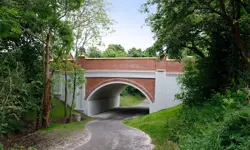
FlexiArch
Arch bridges are strong, durable and require little maintenance. However, very few had been built since the early 1900s until the FlexiArch was developed and launched in 2007. Now, there has been a minor renaissance for this ancient form of construction.

Creating user-friendly buildings
For Michelle McDowell, a former Business Woman of the Year, a passion for joined-up design thinking and building information modelling with a user-friendly approach has enabled her to pioneer revolutionary changes in her field.

Troja Bridge
In November 2014, one of the world’s largest network arch bridges was officially opened in Prague. The UK may soon have its first network arch bridge if the go-ahead is given for a new rail project in Manchester.
Other content from Ingenia
Quick read

- Environment & sustainability
- Opinion
A young engineer’s perspective on the good, the bad and the ugly of COP27

- Environment & sustainability
- Issue 95
How do we pay for net zero technologies?
Quick read

- Transport
- Mechanical
- How I got here
Electrifying trains and STEMAZING outreach

- Aerospace
- Electricals & electronics
- Issue 95